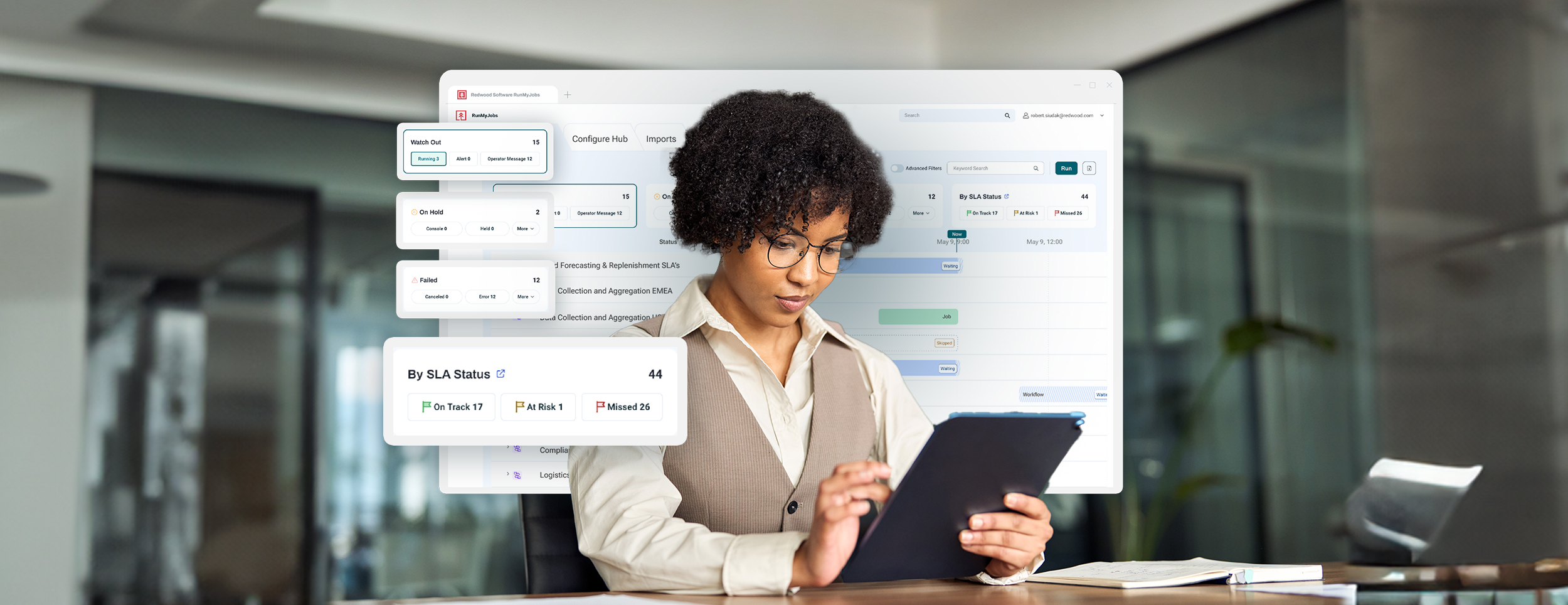How the best monitoring and observability tools prevent missed SLAs

SLAs represent commitments to your customers and internal stakeholders, and they’re often tied to specific performance metrics. Missing your targets for uptime, response time, processing throughput and other key data points can result in significant financial and reputational damage.
In large enterprises, SLAs are more than just contractual obligations; they’re fundamental to maintaining trust both internally and externally. Failing to meet them doesn’t just affect a single project or department; it can have a cascading effect and cause bottlenecks or delays on a wide scale.
Unfortunately, many automation tools fall short in preventing SLA breaches because they lack the sophisticated observability capabilities necessary for proactive SLA management.
The cost of missed SLAs in enterprise IT
For large enterprises, the repercussions of missed SLAs extend beyond operational hiccups to tangible financial penalties, customer relationship strains and more.
The financial implications alone can be staggering, with breached SLAs costing companies millions of dollars. Siemens reports that unplanned downtime costs $2 million an hour in some sectors. Those governed by strict contractual obligations, such as telecommunications, financial services and healthcare, can experience financial hits that cut into profits, hinder growth and negatively impact future financial planning. The compounding effect makes it even harder to invest in the advanced technologies necessary to prevent future failures.
Reputational damage can be just as severe, if not worse. In competitive markets, your reputation for reliability and performance can be ruined by repeated SLA failures. Customers and partners expect consistent service delivery, and delays can cause frustration, dissatisfaction and, ultimately, loss of business. Once trust is broken, it becomes difficult to regain, especially if your industry thrives on word-of-mouth marketing. Not to mention, SLA breaches could endanger your compliance with industry regulations.
A pattern of missed SLAs often indicates stagnation in automation maturity. If your organization consistently fails to meet these commitments, it could be that you lack the insights and advanced monitoring necessary to optimize your automation strategy. Your IT and operations teams may be in reactive mode, constantly fighting fires instead of strategically improving systems and workflows. It’s likely you’ll miss opportunities to move toward more efficient processes and remain in a manually driven state. A lack of growth in automation maturity prevents your enterprise from enjoying the cost savings and efficiency gains that come with a well-optimized automation strategy.
Reactive vs. proactive IT management
One of the most pressing challenges in IT today is how to approach moving from traditional monitoring tools to the gold standard: complete visibility. With simple alerts, your team may not become aware of an issue until it’s already caused a ripple effect across your operations, including missed SLAs. You need to be able to anticipate and prevent problems in plenty of time.
While monitoring tools typically track metrics like CPU usage, memory consumption or job completion rates, they offer limited context. Being alerted when something goes wrong doesn’t help you understand why it went wrong or, more importantly, how to prevent it in the future. The lack of contextual information leads to inefficient troubleshooting and longer downtime.
A comprehensive observability platform goes beyond tracking to aggregate logs, metrics and traces from across your entire environment to give you a full view of system health and workflow performance. Modern observability, built into Service Orchestration and Automation Platforms (SOAPs), incorporates AI and machine learning to deliver insights that traditional monitoring tools can’t. Predictive tools help you learn from past scheduling, resource availability and on-time completion data to predict current and future SLA breaches.
By 2029, 75% of SOAP workflows will leverage generative AI (GenAI) to increase troubleshooting efficiency by 50% — up from less than 10% in 2025.
Proactive management in utilities
Consider a utility company managing automated billing for millions of customers.
The reactive way: The team gets a notification after a significant delay has already occurred in generating bills for customers. They have to scramble to find the root cause across departmental and technical silos, but the delay has resulted in a breached SLA for timely billing delivery. The damage is done: Customer service is inundated with calls and financial penalties are imposed.
The proactive way: Using a SOAP with observability dashboards, the team sees that latency is increasing in its billing process. The platform’s predictive analytics flag this anomaly as a potential risk to SLAs. IT can then reallocate resources, address the root cause and ensure billing is completed on time. They avoid a breach entirely.
Systemic anomalies and predictive alerts: A safety net
SOAP platforms equipped with advanced observability tools scan your entire environment to detect anomalies and provide predictive alerts — a far cry from the binary thresholds that trigger alerts in a traditional monitoring system.
By analyzing trends over time, they can forecast potential failures or inefficient workflows. Whether an automation is currently running or scheduled for the future, the best observability solutions will be able to predict when failure is likely.
Beyond anomaly detection, advanced observability platforms leverage AI to rank irregularities by severity and impact so your team can prioritize responses based on the potential risk to critical SLAs.
Predictive alerts can also forecast demand spikes, system overloads or even security vulnerabilities based on historical data.
This level of visibility means you can stop SLA breaches before they happen, a dramatic shift from having to disrupt operations to react every time a system performance issue is detected.
Achieve ultimate visibility with a SOAP
In high-stakes IT environments, relying on limited automation tools with basic monitoring capabilities is a risky strategy. You’re effectively flying blind, with minimal visibility into what’s really happening in your systems and workflows.
A SOAP platform gives you ultimate visibility by aggregating data, leveraging AI and offering predictive insights. It doesn’t just tell you when something is wrong — it tells you why it’s wrong and how to fix it. Investing in a platform with first-rate observability and an intuitive user experience will help you avoid the financial penalties, reputational bruising and customer dissatisfaction that accompany SLA breaches, no matter your use cases.
Consider a recognized SOAP solution to meet your observability needs. Redwood Software is a 2025 Gartner® Magic Quadrant™ for SOAP Leader. Find out why in the full analyst report.
About The Author

Abhijit Kakhandiki
Abhijit is the Chief Product Officer for Redwood Software. He is a seasoned executive with a proven track record in driving new product development, go-to-market, and improved product P&L performance. Abhijit has held Chief Product Officer (CPO) roles for both private and public companies, leading products and engineering initiatives. He has helped numerous companies navigate through successful digital transformations, including leading LiveRamp through the sea-change in AdTech, driving the cloud transformation for Autodesk, directing the Oracle team through a next generation Innovation Management Initiative, and steering product management and strategy for Product Lifecycle Management and Analytics applications at Agile Software.